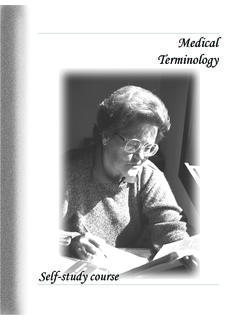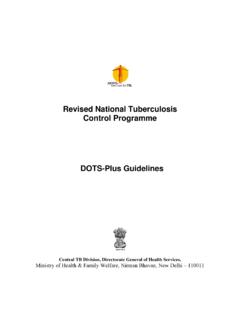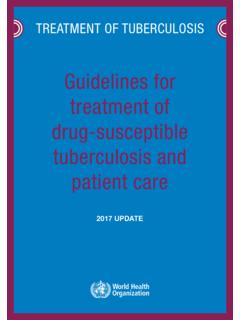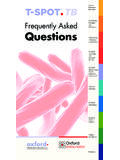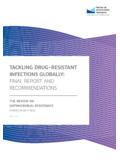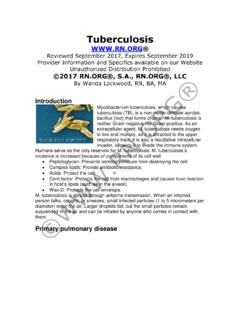Transcription of TUBERCULOSIS EXPOSURE CONTROL PLAN For LONG TERM …
1 Guidelines for TB Screening in LTC Facilities for the Elderly in Oregon November 2002 1 Oregon Guidelines TUBERCULOSIS EXPOSURE CONTROL plan For LONG TERM CARE FACILITIES FOR THE ELDERLY November 2002 Approved: Evelyn Lancaster, , Mark Loveless, TB Controller Medical Epidemiologist Oregon Health Services HIV/STD/TB Programs Oregon Health Services Prepared In consultation with: Robert Preston, MS, Geriatric Infection CONTROL Consultant Linda Kirshbaum, BS, NHA, Oregon Health Care Association Margaret Carley, RN, JD, Oregon Health Care Association Suzanne Banda, PHN, MPH Oregon TB Nurse Consultant James Marx, , , , Infection CONTROL & Epidemiology Consultant Jean Adams, , Infection CONTROL Coordinator and Director of Staff Development for Castle Manor Virginia Gothard, , Infection CONTROL Coordinator for Friendship Manor NOTE: No set of guidelines can cover all individual situations which can and will arise.
2 Thus when questions on individual situations not covered by these guidelines do arise, consult with your local health department TUBERCULOSIS CONTROL program for further information. Guidelines for TB Screening in LTC Facilities for the Elderly in Oregon November 2002 2 A. Purpose, Goal, and How to Use .. 3-4 B. TB CONTROL plan 1. TB Risk Assessment .. 5 2. Surveillance / Screening for Infection a. Diagnosis of 12 (1) 12 (2) Staff and 15 b. 17 3. Containment / Screening for Active TB Disease a. Resident with a Negative Tuberculin Skin 17 b. Resident with a Positive Tuberculin Skin 18 c. 20 d. 20 e. Treatment .. 21 f. Investigation of 21 4.
3 22 5. 22 C. Attachments: A. Guidelines for Interpretation of TB Skin Test Reactions in Oregon .. 23 B. Two-Step Tuberculin Skin Tests (Mantoux) .. 24 C. BCG Information Sheet .. 26 D. Resident Annual TUBERCULOSIS Screening Questionnaire .. 27 E. Employee Annual TUBERCULOSIS Screening Questionnaire .. 29 F. Investigation for Contacts .. 30 G. Sample post positive TST evaluation forms (3 - staple together as a packet) .. 33 H. Resources .. 36 I. Sample staff TB training preview .. 37 Guidelines for TB Screening in LTC Facilities for the Elderly in Oregon November 2002 3 PURPOSE This document has been produced to provide standard TUBERCULOSIS (TB) screening and surveillance guidelines for facilities licensed as Long Term Care Facilities for the Elderly in Oregon. It is designed to be consistent with OARs 333-019-0041 and is based on local TB epidemiology and follows the Centers for Disease CONTROL and Prevention guidelines: - Prevention and CONTROL of TUBERCULOSIS in Facilities Providing Long Term Care to the Elderly, 1990, MMWR; Vol 39 No.
4 RR-10, and - Guidelines for Preventing the Transmission of Mycobacterium TUBERCULOSIS in Health-Care Facilities, 1994 MMWR October 28, 1994; No. RR-13); pages 1-132. Adult foster care homes, board and care homes, other residential and congregate settings, who are not licensed as Long Term Care Facilities for the Elderly, are not required by Oregon rule 333-019-0041 to screen for TUBERCULOSIS . In the rare event that an EXPOSURE may occur, the facility should follow the case management and contact follow-up recommendations from the local health department. Some facilities may have other rules or regulations regarding TB screening and should contact the agency that requires the screening to obtain direction in complying with those regulations. Facilities who plan to provide care for infectious TUBERCULOSIS patients on-site should insert procedures and policies for managing infectious TUBERCULOSIS patients into these guidelines.
5 GOAL It is the goal of all long term care facilities to assure that appropriate TUBERCULOSIS prevention and CONTROL activities are undertaken to protect residents and staff. The Infection CONTROL Committee is responsible for implementation of the facility s TB CONTROL plan . Each facility should assign an appropriate member to oversee implementation of the TB CONTROL activities of risk assessment, surveillance, containment, assessment, and education. There are five elements to the TB CONTROL plan : 1. Risk Assessment Annually, each facility should evaluate their TB risk for transmission of The results of this assessment will guide the extent to which the other components are followed. 2. Surveillance: Identifying and reporting all cases of TB in the facility, and identify infected residents and staff. 3. Containment: Screening for disease and ensuring that transmission of TB is stopped promptly.
6 4. Assessment: Monitoring and evaluating surveillance and containment activities of the facility. 5. Education: Providing information and imparting skills to staff, patients, and visitors so that they understand and cooperate with appropriate TB CONTROL Activities. Guidelines for TB Screening in LTC Facilities for the Elderly in Oregon November 2002 4 How to Use this document: 1. Determine your facility s TB risk - see Section 1. TB Risk Assessment a. Complete the TB Surveillance / Risk Assessment Record for the last year. The number of cases in the county and in your facility last year determine your TB risk category (listed below). b. Select the appropriate TB CONTROL plan Summary for the Year ____ 1) Minimal Risk = No TB in county and facility did not have any TB cases in last year. 2) Very Low Risk = TB is reported in the county, but no TB cases occurred in facility last year.
7 3) Low or Intermediate Risk = TB is reported in the county, and TB cases occurred in facility last year. (If unsure if there were cases in your county, call your local health department or look online at: ) 2. Fill in the date each element/activity was completed or reviewed and by who. 3. Review your TB CONTROL plan to make sure your policies are consistent for your type of facility and the guidelines. a. TB CONTROL plan reviewed b. TB Education & Training of Staff is scheduled / performed c. Screening of Staff (HCWs): policy is current d. Screening of Residents: policy is current e. Reporting: have a plan for reporting if needed Guidelines for TB Screening in LTC Facilities for the Elderly in Oregon November 2002 5 1. TB RISK ASSESSMENT The purpose of the TB risk assessment is to evaluate the actual risk of TB transmission for a particular facility.
8 Facilities should keep a record of the following information for both staff and residents each year: the number of TST reactors (+ TST who are not currently considered converters), the number of TST conversions1, and the number of cases of active TB diagnosed the number of TB cases in the community (county), and TB drug resistance patterns for the State. Each year, the designated staff person can check with the Local Health Department or the Oregon Health Services TB CONTROL web page ( ) for the most current year s reported active TB and resistance data. Final case counts are reported by county; however, are not available before April of the following year ( the case count for 2000 will not be available before April of 2001). Facilities can use the TB Surveillance / Risk Assessment Record (see next page) to enter this data and determine the TB risk status for their facility annually.
9 For the TB Surveillance / Risk Assessment Record: 1. Obtain the community profile data. 2. Enter Mantoux Test and active TB Disease information from your facility. 3. Determine the TB risk category which matches your facility s risk category. 1) Minimal Risk = No TB in county and facility did not have any TB cases in last year. 2) Very Low Risk = TB is reported in the county, however no TB cases occurred in facility last year. 3) Low or Intermediate Risk = TB is reported in the county, and TB cases occurred in facility last year. 4) High Risk = Ongoing transmission Most facilities in Oregon will be Minimal or Very Low Risk categories. 1 Conversion= written documentation of a change in TST result from a negative to a positive within the last 2 years, AND the reaction increased in size by at least 10mm induration. Guidelines for TB Screening in LTC Facilities for the Elderly in Oregon November 2002 6 TB Surveillance/ Risk Assessment Record Institution: Year: A.
10 Community Profile: ( or call local health department for data) 1. Number of cases of active TB reported in the County: _____ 2. Drug resistance within the State: Resistant to INH= _____% Resistant to at least INH & RIF= _____% B. Positive Mantoux Tests in the facility: Number of positive % of total residents % of total staff Residents Staff C. Mantoux Test Conversions : IF annual testing is done (skin test negative to positive within last 2 years AND there was an increase of at least 10mm in size of reaction) Number converted % of total residents % of total staff Residents Staff Source of EXPOSURE known? Name Date of conversion Location Room or Unit Yes No D. Active TB Disease: Number with active TB % of all residents % of all staff Residents Staff Contact to another case? Reported on OSHA log?
